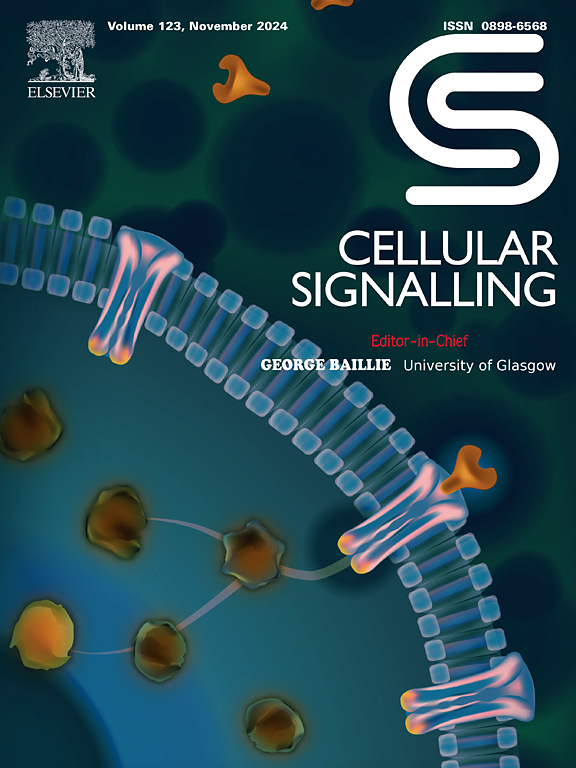甲基参皂酮A通过抑制JNK1信号通路缓解糖尿病性心肌病
IF 4.4
2区 生物学
Q2 CELL BIOLOGY
引用次数: 0
摘要
目的:糖尿病性心肌病(DCM)是2型糖尿病(T2DM)的常见并发症。本文研究了具有抗炎作用的天然同型异黄酮-甲基苦参酮A (MO-A)对DCM的作用及其机制。方法连续7 d腹腔注射链脲佐菌素30 mg/kg诱导T2DM小鼠模型,并饲喂高脂饲料12周。T2DM小鼠接受MO-A(2.5、5或10 mg/kg)治疗两周。评估心功能、肥厚、纤维化和炎症。通过分子对接分析MO-A与JNK1之间的结合能。在高糖(HG)诱导的H9C2细胞中进一步研究了其潜在机制。评估细胞毒性作用、心肌细胞肥大、纤维化、炎症和相关信号蛋白。结果smo - a治疗可减轻DCM小鼠的心功能和组织病理学改变。此外,MO-A处理显著降低了DCM小鼠大肠杆菌、TGF-β1、MYH7和ANP的表达水平。此外,MO-A处理后,DCM小鼠TNF-α、IL-6和IL-1β的表达水平明显下调。在体外也观察到类似的结果。在机制上,MO-A在DCM小鼠中靶向JNK1并下调其磷酸化水平。在hg诱导的H9C2细胞中,JNK1过表达逆转了MO-A的保护作用。结论MO-A可通过抑制JNK1信号通路改善DCM的心功能、肥厚、纤维化和炎症。本文章由计算机程序翻译,如有差异,请以英文原文为准。
Methylophiopogonanone A alleviates diabetic cardiomyopathy via inhibiting JNK1 signaling
Objective
Diabetic cardiomyopathy (DCM) is a common complication of type 2 diabetes mellitus (T2DM). The effects of methylophiopogonanone A (MO-A), a natural homoisoflavonoid with anti-inflammatory effects, on DCM and its underlying mechanisms were investigated in this study.
Methods
The T2DM mouse model was induced by intraperitoneal injection of 30 mg/kg streptozotocin for 7 consecutive days and fed with a high-fat diet for 12 weeks. T2DM mice received MO-A (2.5, 5, or 10 mg/kg) treatment for two weeks. Cardiac function, hypertrophy, fibrosis, and inflammation were evaluated. The binding energy between MO-A and JNK1 was analyzed using molecular docking. The underlying mechanism was further investigated in high glucose (HG)-induced H9C2 cells. The cytotoxic effects, cardiomyocyte hypertrophy, fibrosis, inflammation, and relevant signaling proteins were assessed.
Results
MO-A treatment alleviated cardiac function and histopathological changes in DCM mice. Moreover, MO-A treatment significantly decreased COL![]() I, TGF-β1, MYH7, and ANP expression levels in DCM mice. Furthermore, TNF-α, IL-6, and IL-1β expression levels were notably downregulated after treatment with MO-A in DCM mice. Similar results were also observed in vitro. Mechanistically, MO-A targets JNK1 and downregulates its phosphorylation levels in DCM mice. The protective properties of MO-A were reversed by JNK1 overexpression in HG-induced H9C2 cells.
I, TGF-β1, MYH7, and ANP expression levels in DCM mice. Furthermore, TNF-α, IL-6, and IL-1β expression levels were notably downregulated after treatment with MO-A in DCM mice. Similar results were also observed in vitro. Mechanistically, MO-A targets JNK1 and downregulates its phosphorylation levels in DCM mice. The protective properties of MO-A were reversed by JNK1 overexpression in HG-induced H9C2 cells.
Conclusion
Our results revealed that MO-A could alleviate cardiac function, hypertrophy, fibrosis, and inflammation in DCM via inhibiting JNK1 signaling.
求助全文
通过发布文献求助,成功后即可免费获取论文全文。
去求助
来源期刊

Cellular signalling
生物-细胞生物学
CiteScore
8.40
自引率
0.00%
发文量
250
审稿时长
27 days
期刊介绍:
Cellular Signalling publishes original research describing fundamental and clinical findings on the mechanisms, actions and structural components of cellular signalling systems in vitro and in vivo.
Cellular Signalling aims at full length research papers defining signalling systems ranging from microorganisms to cells, tissues and higher organisms.
 求助内容:
求助内容: 应助结果提醒方式:
应助结果提醒方式:


